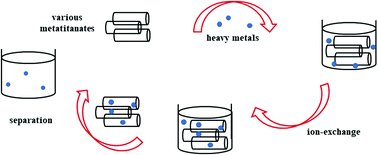Highly-efficient removal of Pb(ii), Cu(ii) and Cd(ii) from water by novel lithium, sodium and potassium titanate reusable microrods†
Abstract
In this work, we report on the efficient removal of heavy metal ions with nanostructured lithium, sodium and potassium titanates from simulated wastewater. The titanates were obtained via a fast, easy and cost effective process based on extraction of sulfate ions from the crystals of titanyl sulfate and their replacement with hydroxyl groups of NaOH, LiOH and KOH solutions leaving the Ti–O framework intact. The as-prepared titanates were carefully examined by scanning and transmission electron microscopy. Furthermore, the effect of contact time, pH, annealing temperature, together with adsorption in real conditions including competitive adsorption and reusability were studied. It was found that the maximum adsorption capacity, as calculated from the Langmuir adsorption model, is up to 3.8 mmol Pb(II) per g, 3.6 mmol Cu(II) per g and 2.3 mmol Cd(II) per g. Based on the characterization results, a possible mechanism for heavy metal removal was proposed. This work provides a very efficient, fast and convenient approach for exploring promising materials for water treatment.



 Please wait while we load your content...
Please wait while we load your content...